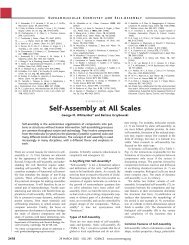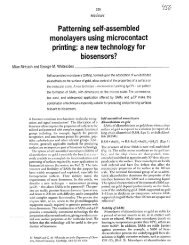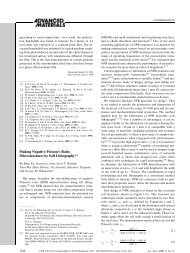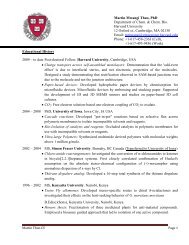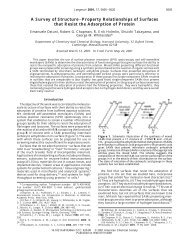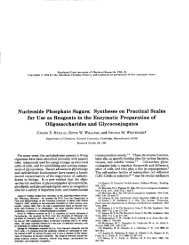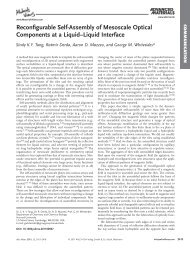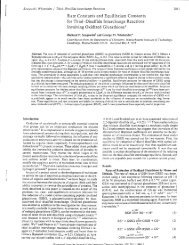Self-Assembled Monolayers of Thiolates on Metals as - Whitesides ...
Self-Assembled Monolayers of Thiolates on Metals as - Whitesides ...
Self-Assembled Monolayers of Thiolates on Metals as - Whitesides ...
Create successful ePaper yourself
Turn your PDF publications into a flip-book with our unique Google optimized e-Paper software.
1136 Chemical Reviews, 2005, Vol. 105, No. 4 Love et al.<br />
ing is, however, a process that does occur in microc<strong>on</strong>tact<br />
printing and is <strong>on</strong>e factor that limits the<br />
performance <str<strong>on</strong>g>of</str<strong>on</strong>g> this method <str<strong>on</strong>g>of</str<strong>on</strong>g> replicati<strong>on</strong>.<br />
Vapor transport is a primary mechanism for the<br />
spreading <str<strong>on</strong>g>of</str<strong>on</strong>g> SAMs in regi<strong>on</strong>s not c<strong>on</strong>tacted by the<br />
stamp, but it is not clear what role, if any, it plays<br />
in forming SAMs where the stamp c<strong>on</strong>tacts the<br />
surface. On a polycrystalline film with variati<strong>on</strong>s in<br />
roughness <str<strong>on</strong>g>of</str<strong>on</strong>g> ∼3-10 nm it is possible that the stamp<br />
does not make van der Waals c<strong>on</strong>tacts with the entire<br />
exposed surface, especially in the crevices between<br />
the grains <str<strong>on</strong>g>of</str<strong>on</strong>g> the thin film. Whether surface-mediated<br />
diffusi<strong>on</strong> or vapor transport through the air leads to<br />
the formati<strong>on</strong> <str<strong>on</strong>g>of</str<strong>on</strong>g> SAMs in the crevices is not understood.<br />
Experiments using wet-chemical etchants to<br />
transfer patterns <str<strong>on</strong>g>of</str<strong>on</strong>g> SAMs into underlying metal<br />
films suggest that the boundaries between the grains<br />
<str<strong>on</strong>g>of</str<strong>on</strong>g> the thin film are susceptible to corrosi<strong>on</strong> 220,516,517<br />
and may indicate that SAMs have a higher degree<br />
<str<strong>on</strong>g>of</str<strong>on</strong>g> disorder when formed in the crevices than <strong>on</strong> the<br />
tops <str<strong>on</strong>g>of</str<strong>on</strong>g> the grains.<br />
7.1.4. Structure <str<strong>on</strong>g>of</str<strong>on</strong>g> SAMs Formed by µCP<br />
The compositi<strong>on</strong>, m<strong>as</strong>s coverage, and organizati<strong>on</strong><br />
<str<strong>on</strong>g>of</str<strong>on</strong>g> SAMs formed by µCP have been studied by c<strong>on</strong>tact<br />
angle g<strong>on</strong>iometry, 511,518 STM, 508,518 AFM, 507,509,519<br />
XPS, 511,520 RAIRS, 30,511 ellipsometry, 514 electrochemistry,<br />
508 time-<str<strong>on</strong>g>of</str<strong>on</strong>g>-flight sec<strong>on</strong>dary-i<strong>on</strong> m<strong>as</strong>s spectrometry<br />
(TOF-SIMS), 520 GIXD, 519 NEXAFS, 507 and sumfrequency<br />
generati<strong>on</strong> (SFG) spectroscopy. 511,521 Direct<br />
comparis<strong>on</strong>s between studies <str<strong>on</strong>g>of</str<strong>on</strong>g> the organizati<strong>on</strong> <str<strong>on</strong>g>of</str<strong>on</strong>g><br />
SAMs formed by µCP are complicated by a lack <str<strong>on</strong>g>of</str<strong>on</strong>g><br />
standards for c<strong>on</strong>ducting the printing experiments<br />
(methods for applying thiols to the stamps, durati<strong>on</strong><br />
<str<strong>on</strong>g>of</str<strong>on</strong>g> printing times, etc.). Taken together, however, the<br />
data from these studies indicate that the SAMs<br />
formed by µCP are usually a complex mixture <str<strong>on</strong>g>of</str<strong>on</strong>g><br />
ph<strong>as</strong>es but can reach a state <str<strong>on</strong>g>of</str<strong>on</strong>g> organizati<strong>on</strong> that is<br />
spectroscopically indistinguishable from SAMs formed<br />
by adsorpti<strong>on</strong> from soluti<strong>on</strong>.<br />
STM studies show that the SAMs formed by µCP<br />
for 3-5 s with 1-10 mM soluti<strong>on</strong>s <str<strong>on</strong>g>of</str<strong>on</strong>g> dodecanethiol<br />
<strong>on</strong> Au(111) exhibit a mixture <str<strong>on</strong>g>of</str<strong>on</strong>g> structures. 518 The<br />
structures observed include disordered, liquidlike<br />
regi<strong>on</strong>s, striped ph<strong>as</strong>es with p × �3 packing arrangements<br />
(p ) 3.5, 4, 8, 5), and dense (�3 �3)-<br />
R30° structures with a c4 × 2 superlattice. The SAMs<br />
formed in these experiments c<strong>on</strong>sisted <str<strong>on</strong>g>of</str<strong>on</strong>g> islands <str<strong>on</strong>g>of</str<strong>on</strong>g><br />
dense (�3 × �3)R30° structures (∼50-200 nm<br />
diameter) surrounded with striped ph<strong>as</strong>es and disordered<br />
regi<strong>on</strong>s; the crystalline islands were separated<br />
by distances <str<strong>on</strong>g>of</str<strong>on</strong>g> ∼100 nm and occupied <strong>on</strong>ly 20-<br />
40% <str<strong>on</strong>g>of</str<strong>on</strong>g> the surface. SAMs formed by µCP with 100<br />
mM soluti<strong>on</strong>s <str<strong>on</strong>g>of</str<strong>on</strong>g> thiol were nearly identical to those<br />
formed from soluti<strong>on</strong> (1 mM for 18 h): they c<strong>on</strong>tained<br />
<strong>on</strong>ly (�3 ×�3)R30° structures and c4 × 2 superlattices<br />
<str<strong>on</strong>g>of</str<strong>on</strong>g> the (�3 ×�3)R30° structures. The experiments<br />
suggested that the percentage <str<strong>on</strong>g>of</str<strong>on</strong>g> each type <str<strong>on</strong>g>of</str<strong>on</strong>g><br />
structure and the domain sizes <str<strong>on</strong>g>of</str<strong>on</strong>g> the structures<br />
depend <strong>on</strong> the c<strong>on</strong>centrati<strong>on</strong> <str<strong>on</strong>g>of</str<strong>on</strong>g> thiol used for printing<br />
and not small variati<strong>on</strong>s in c<strong>on</strong>tact time (0.3-30 s).<br />
RAIR spectra and c<strong>on</strong>tact angle me<strong>as</strong>urements<br />
suggest that the eliminati<strong>on</strong> <str<strong>on</strong>g>of</str<strong>on</strong>g> c<strong>on</strong>formati<strong>on</strong>al defects<br />
(and probably low m<strong>as</strong>s coverage ph<strong>as</strong>es <strong>as</strong> well)<br />
requires printing times from 1 min to 1 h; this time<br />
is less than that required in soluti<strong>on</strong> (12-18 h). 30,507,511<br />
RAIR spectra also suggest that c<strong>on</strong>centrated soluti<strong>on</strong>s<br />
<str<strong>on</strong>g>of</str<strong>on</strong>g> thiols (∼100 mM) generate SAMs with a<br />
higher degree <str<strong>on</strong>g>of</str<strong>on</strong>g> chain organizati<strong>on</strong> than low c<strong>on</strong>centrati<strong>on</strong>s<br />
(1-10 mM) when the stamps are applied<br />
to the surface for the same amount <str<strong>on</strong>g>of</str<strong>on</strong>g> time (60 s). 30<br />
Studies using SFG microscopy have shown that the<br />
edges <str<strong>on</strong>g>of</str<strong>on</strong>g> 10 µm features printed <strong>on</strong> metal surfaces<br />
are not sharp and lead to regi<strong>on</strong>s <str<strong>on</strong>g>of</str<strong>on</strong>g> mixed SAMs<br />
when the bare regi<strong>on</strong>s <str<strong>on</strong>g>of</str<strong>on</strong>g> the substrate are filled with<br />
a sec<strong>on</strong>d SAM. 521<br />
Overall, the data indicate that the SAMs formed<br />
by µCP <strong>on</strong> polycrystalline films <str<strong>on</strong>g>of</str<strong>on</strong>g> metal and used in<br />
most applicati<strong>on</strong>s are not equivalent to those formed<br />
in soluti<strong>on</strong> when formed by printing for 1-10 s with<br />
stamps inked with 1-10 mM soluti<strong>on</strong>s <str<strong>on</strong>g>of</str<strong>on</strong>g> thiol. The<br />
thiols present near the surface <str<strong>on</strong>g>of</str<strong>on</strong>g> the stamp are<br />
resp<strong>on</strong>sible for the n<strong>on</strong>equilibrium state generated<br />
when printing for <strong>on</strong>ly a few sec<strong>on</strong>ds; it requires<br />
additi<strong>on</strong>al time for thiols to diffuse from the bulk <str<strong>on</strong>g>of</str<strong>on</strong>g><br />
the stamp to the surface to incre<strong>as</strong>e the m<strong>as</strong>s<br />
coverage.<br />
The transiti<strong>on</strong> in the structure <str<strong>on</strong>g>of</str<strong>on</strong>g> a SAM from the<br />
printed to n<strong>on</strong>printed regi<strong>on</strong>s h<strong>as</strong>, to the best <str<strong>on</strong>g>of</str<strong>on</strong>g> our<br />
knowledge, not been observed directly, but the dependence<br />
<str<strong>on</strong>g>of</str<strong>on</strong>g> the surface structure <strong>on</strong> the c<strong>on</strong>centrati<strong>on</strong><br />
<str<strong>on</strong>g>of</str<strong>on</strong>g> thiols loaded into the stamp also implies that<br />
the structure <str<strong>on</strong>g>of</str<strong>on</strong>g> SAMs near the edges <str<strong>on</strong>g>of</str<strong>on</strong>g> printed<br />
features is different than that in the centers. On the<br />
b<strong>as</strong>is <str<strong>on</strong>g>of</str<strong>on</strong>g> STM data for different c<strong>on</strong>centrati<strong>on</strong>s <str<strong>on</strong>g>of</str<strong>on</strong>g><br />
thiols applied by printing, 518 <strong>on</strong>e possible structural<br />
transiti<strong>on</strong> could include an incre<strong>as</strong>e in the size <str<strong>on</strong>g>of</str<strong>on</strong>g> the<br />
(�3 ×�3)R30° domains close to the edges <str<strong>on</strong>g>of</str<strong>on</strong>g> printed<br />
features and a high percentage <str<strong>on</strong>g>of</str<strong>on</strong>g> low-density striped<br />
ph<strong>as</strong>es (>60%). As the distance away from the edges<br />
<str<strong>on</strong>g>of</str<strong>on</strong>g> the printed regi<strong>on</strong>s incre<strong>as</strong>es, the m<strong>as</strong>s coverage<br />
must decre<strong>as</strong>e; the low m<strong>as</strong>s coverage would imply<br />
a more disordered or liquidlike state. Such variati<strong>on</strong>s<br />
in structure have been observed for SAMs patterned<br />
by dip-pen lithography. 522<br />
7.1.5. Transfer <str<strong>on</strong>g>of</str<strong>on</strong>g> PDMS to the Surface during Printing<br />
Some studies report that trace c<strong>on</strong>taminants <str<strong>on</strong>g>of</str<strong>on</strong>g><br />
PDMS are left <strong>on</strong> the surface after printing. 511,520,523<br />
The effect <str<strong>on</strong>g>of</str<strong>on</strong>g> these c<strong>on</strong>taminants <strong>on</strong> the structure and<br />
properties <str<strong>on</strong>g>of</str<strong>on</strong>g> the SAMs is not clear. The compositi<strong>on</strong><br />
<str<strong>on</strong>g>of</str<strong>on</strong>g> the prepolymer, the time over which the crosslinked<br />
PDMS is cured, the exact ratio <str<strong>on</strong>g>of</str<strong>on</strong>g> comp<strong>on</strong>ents<br />
in the prepolymer, and the procedures used to extract<br />
low molecular weight siloxanes probably determine<br />
the degree <str<strong>on</strong>g>of</str<strong>on</strong>g> c<strong>on</strong>taminati<strong>on</strong>. 497<br />
7.1.6. Fabricati<strong>on</strong> <str<strong>on</strong>g>of</str<strong>on</strong>g> Nanostructures by µCP<br />
It is possible to form nanostructures by µCP with<br />
lateral dimensi<strong>on</strong>s <strong>as</strong> small <strong>as</strong> 50 nm, but the<br />
fabricati<strong>on</strong> <str<strong>on</strong>g>of</str<strong>on</strong>g> such structures by µCP remains a more<br />
significant challenge than producing micrometerscale<br />
patterns by µCP. 31,131,220,524-527 Two key factors<br />
that determine the limits <str<strong>on</strong>g>of</str<strong>on</strong>g> resoluti<strong>on</strong> are lateral<br />
diffusi<strong>on</strong> <str<strong>on</strong>g>of</str<strong>on</strong>g> the molecules and distorti<strong>on</strong>s <str<strong>on</strong>g>of</str<strong>on</strong>g> the<br />
stamp. Lateral broadening <str<strong>on</strong>g>of</str<strong>on</strong>g> the printed features<br />
results from diffusi<strong>on</strong> <str<strong>on</strong>g>of</str<strong>on</strong>g> the molecular ink through<br />
the g<strong>as</strong> ph<strong>as</strong>e or through a surface-mediated process.




